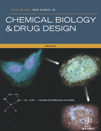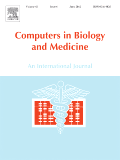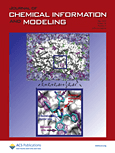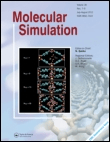
JOURNAL OF COMPUTER-AIDED MOLECULAR DESIGN
metrics 2024
Elevating Research Standards in Computer-Aided Molecular Design
Introduction
JOURNAL OF COMPUTER-AIDED MOLECULAR DESIGN, published by Springer, serves as a premier platform for researchers in the fields of computer science applications, drug discovery, and physical and theoretical chemistry. Since its inception in 1987, the journal has played a pivotal role in advancing the methodologies and technologies used in molecular design and screening. With an impressive impact factor and a ranking within the top quartile across related disciplines, this journal offers invaluable insights and innovative approaches that are essential for scholars and practitioners in these dynamic fields. The journal's rigorous peer-review process ensures high-quality publications that contribute significantly to both theoretical and practical advancements. Though it operates under a subscription model, the journal remains dedicated to fostering knowledge dissemination and collaboration among researchers.
Metrics 2024
 0.61
0.61 3.00
3.00 2.90
2.90 119
119Metrics History
Rank 2024
Scopus
IF (Web Of Science)
JCI (Web Of Science)
Quartile History
Similar Journals

Chemical Biology & Drug Design
Exploring the frontiers of medicinal chemistry and drug design.Chemical Biology & Drug Design, an esteemed publication by WILEY, serves as a vital platform for the dissemination of pioneering research in the interdisciplinary fields of biochemistry, drug discovery, molecular medicine, organic chemistry, and pharmacology. With a dedicated commitment to advancing the understanding of chemical interactions and drug development, this journal not only fosters innovation but also bridges the gap between theoretical research and practical applications. It boasts an impressive impact factor and is recognized in the 2023 category quartiles as Q3 in Biochemistry and Molecular Medicine, and Q2 in Drug Discovery, Organic Chemistry, and Pharmacology, indicating its relevance and influence in these crucial areas. The journal’s rankings across various Scopus categories further solidify its position as a reputable resource for researchers, professionals, and students striving to stay at the forefront of medicinal chemistry and drug design. While primarily traditional access-based, the journal's evolving scope from 2006 to 2024 ensures an ongoing contribution to essential scientific dialogue, making it an indispensable read for those committed to advancing health sciences.

PROTEIN JOURNAL
Advancing Knowledge in Protein ChemistryProtein Journal, published by Springer, stands as a significant academic resource in the fields of Analytical Chemistry, Biochemistry, Bioengineering, and Organic Chemistry. Since its inception in 1996, the journal has dedicated itself to the dissemination of high-quality research focused on protein chemistry and its biomedical applications. With an impressive impact reflected in its classification as a Q2 journal in Analytical Chemistry and Q3 in both Biochemistry and Bioengineering as of 2023, it provides an essential platform for researchers and practitioners to share their findings. The journal embraces the open-access model, enhancing accessibility to cutting-edge research. The Protein Journal is crucial for academicians, industry professionals, and students, catering to their need for rigorous scientific discourse and innovative discoveries in protein studies. With an established track record of converging over two decades of knowledge and research, it continues to influence and shape the advancements in this vital area of science.

JOURNAL OF BIOMOLECULAR STRUCTURE & DYNAMICS
Exploring the Intricacies of Biomolecular DynamicsJOURNAL OF BIOMOLECULAR STRUCTURE & DYNAMICS, published by TAYLOR & FRANCIS INC, serves as a pivotal platform for the dissemination of original research in the fields of biochemistry, molecular biology, and structural biology. With an ISSN of 0739-1102 and an E-ISSN of 1538-0254, this esteemed journal has garnered attention for its rigorous peer-review process and commitment to high-quality scientific inquiry since its inception in 1981. Ranking in the Q2 quartile for miscellaneous medicine and the Q3 quartile for both molecular and structural biology, it consistently demonstrates a significant impact within its specialties, evidenced by a high Scopus ranking. Researchers, professionals, and students are encouraged to engage with cutting-edge studies addressing the complex interactions and dynamics of biomolecules, making this journal a vital resource for advancing knowledge in the biological sciences. Although it does not offer open access options, its valuable contributions are vital for the ongoing discourse within the scientific community.

MOLECULAR DIVERSITY
Pioneering Insights into Molecular ComplexityMOLECULAR DIVERSITY, published by Springer, stands as a pivotal platform within the fields of chemistry, biology, and pharmacology since its inception in 1995. This esteemed journal aims to foster interdisciplinary research and innovation, particularly in areas such as catalysis, drug discovery, inorganic and organic chemistry, and molecular biology. With a diverse scope that reflects contemporary scientific challenges, it has been recognized for its significant contributions, boasting commendable Scopus rankings and an impact factor that underscores its relevance in critical fields. Although not an open access journal, MOLECULAR DIVERSITY continues to influence and engage researchers, professionals, and students alike by providing a forum for high-quality peer-reviewed articles and cutting-edge research findings. As it converges years of scientific dynamism from 1995 to 2024, this journal remains vital for those advancing the frontiers of molecular science and engineering.

COMPUTERS IN BIOLOGY AND MEDICINE
Bridging the Gap Between Biology and TechnologyCOMPUTERS IN BIOLOGY AND MEDICINE is a prestigious academic journal published by Pergamon-Elsevier Science Ltd, dedicated to advancing the fields of Computer Science Applications and Health Informatics. With an impressive impact factor and ranking within the Q1 quartile for both categories, this journal plays a crucial role in disseminating high-quality research findings that influence cutting-edge developments at the intersection of computing and healthcare. Covering a broad range of topics from computational biology to medical informatics, it serves as a vital resource for researchers, professionals, and students striving to harness technology for medical advancements. The journal has been publishing since 1970 and continues to evolve, incorporating the latest trends and innovations in the field, thereby ensuring that it remains a key contributor to scientific inquiry and knowledge. With accessible content and a global reach, COMPUTERS IN BIOLOGY AND MEDICINE invites submissions that elevate the understanding and application of computational methods in biological and medical contexts.

CURRENT TOPICS IN MEDICINAL CHEMISTRY
Leading the Way in Medicinal Chemistry ResearchCURRENT TOPICS IN MEDICINAL CHEMISTRY is a prestigious journal published by Bentham Science Publishers Ltd, dedicated to advancing the field of medicinal chemistry through the dissemination of high-quality research from 2001 to 2024. With an ISSN of 1568-0266 and an E-ISSN of 1873-4294, this journal is recognized for its significant contributions, as evidenced by its Scopus ranking in the 63rd percentile in the category of Drug Discovery, specifically at position #58 out of 157. Currently placed in Quartile 3 within Drug Discovery and Quartile 2 in miscellaneous medicine as of 2023, it serves as an essential resource for researchers, professionals, and students interested in the latest developments, methodologies, and applications in medicinal chemistry. The journal aims to foster collaboration and innovation by featuring original research articles, reviews, and brief communications that address current and emerging challenges in the discipline. Although it is not an open access platform, the journal's rich content is indispensable for those striving to enhance therapeutic strategies and drug development processes.

Journal of Chemical Information and Modeling
Transforming Data into Chemical Insights.Journal of Chemical Information and Modeling is a premier scholarly publication dedicated to advancing the fields of chemical engineering, chemistry, and computer science applications. Published by the reputable American Chemical Society, this journal significantly contributes to the scientific community through innovative research and critical reviews that facilitate the understanding and application of chemical information. With an impressive impact factor and a distinguished ranking in multiple categories—such as Q1 in Chemical Engineering and Q1 in Chemistry—the journal is an indispensable resource for researchers and professionals alike. As open access is not currently available, the journal preserves a selective distribution model that ensures high-quality content is accessible to a dedicated audience. By exploring the intersections of data science and chemical informatics, the Journal of Chemical Information and Modeling fosters interdisciplinary collaboration and innovation, positioning itself as a leader in its field. Researchers, professionals, and students are encouraged to engage with this influential platform for the latest developments in chemical information science.

MOLECULAR SIMULATION
Pioneering insights in chemistry, physics, and materials science.MOLECULAR SIMULATION, published by TAYLOR & FRANCIS LTD, stands as a pivotal platform in the interdisciplinary landscape of molecular modeling and simulation, bridging the fields of chemistry, physics, and materials science. Since its inception in 1987, this journal has been dedicated to publishing high-quality research that advances the understanding of complex molecular systems. With a variety of articles covering innovative computational methods and their applications across diverse domains, it resonates well with both established researchers and emerging scholars. Although currently not an open access journal, it maintains a respectable presence within the academic community, illustrated by its Q3 quartile rankings in key categories such as Chemical Engineering, Condensed Matter Physics, and Information Systems as of 2023. Further, its Scopus rankings position it favorably within the respective fields, making it an essential resource for anyone interested in the quantitative aspects of molecular research. With its comprehensive scope, MOLECULAR SIMULATION continues to foster collaboration and innovation, helping to bridge theoretical research with practical applications.

JOURNAL OF RECEPTORS AND SIGNAL TRANSDUCTION
Unlocking the Mysteries of Signal TransductionJOURNAL OF RECEPTORS AND SIGNAL TRANSDUCTION, published by TAYLOR & FRANCIS LTD, is a premier academic journal dedicated to advancing our understanding of receptor biology and signal transduction mechanisms. With an ISSN of 1079-9893 and an E-ISSN of 1532-4281, this journal has maintained a reputable standing since its inception in 1980, continually addressing pivotal topics in biochemistry, cell biology, and molecular biology. As evidenced by its 2023 Scopus rankings, which place it in the 64th percentile for Biochemistry and Genetics and Molecular Biology, JOURNAL OF RECEPTORS AND SIGNAL TRANSDUCTION remains a vital source for cutting-edge research, providing insights that are essential for both academic and practical applications. Although the journal currently offers limited open access options, it stands out in the Q2 and Q3 quartiles of its respective categories, making it an invaluable resource for researchers, professionals, and students aiming to stay abreast of the latest findings and methodologies in receptor and signaling research. The journal's commitment to disseminating high-quality research underscores its significance within the scientific community, fostering innovation and collaboration across disciplines.

Computational and Theoretical Chemistry
Catalyzing Collaboration in Chemistry and PhysicsComputational and Theoretical Chemistry, published by ELSEVIER, stands at the forefront of interdisciplinary research in the realms of computational chemistry, theoretical physics, and biochemistry. With its ISSN 2210-271X and E-ISSN 1872-7999, the journal has established a significant presence in the academic community since its inception. Covering innovative computational methodologies and theoretical advancements, it addresses critical issues in condensed matter physics and molecular biochemistry, providing a rich resource for scholars and industry professionals alike. The journal enjoys a respectable impact factor and ranks notably in several Scopus categories, making it a vital platform for disseminating high-quality research. It adopts an open-access model, facilitating wider readership and engagement, which is essential for fostering collaborative innovations in the scientific landscape. As it continues to evolve from 2011 to 2024, Computational and Theoretical Chemistry is committed to advancing knowledge and promoting insightful discussions within the scientific community.